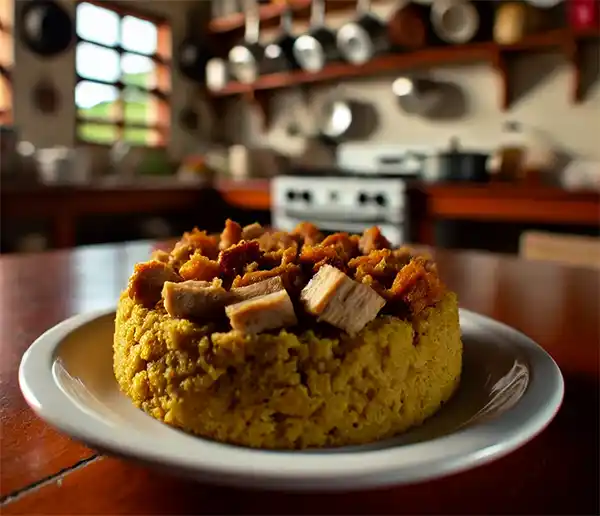A Delicious Mash-Up of Flavor
On National Mofongo Day, we honor one of Puerto Rico’s most beloved dishes, a mashup (quite literally) of savory flavors, history, and, of course, plantains. For those unfamiliar, mofongo is a dish that’s been passed down through generations and has earned its rightful place in the culinary spotlight—though it’s not just any dish. It’s a hearty, flavor-packed celebration in a bowl, combining garlic, pork, and crispy, fried plantains into a mouthwatering creation that might just make you want to move to Puerto Rico.
What is Mofongo, Anyway?
If you’ve never heard of mofongo before, picture this: it starts with green plantains, peeled and fried to golden perfection, then mashed together with garlic, crunchy pork cracklings (chicharrón), and a dash of salt. The result? A golden mound of starchy goodness that’s rich in flavor, slightly crispy on the outside, and delightfully soft inside. It’s served in a bowl, but make no mistake, this is not your average side dish. Mofongo often plays the leading role in meals, whether it’s topped with shrimp, chicken, steak, or a savory broth.
It’s like mashed potatoes but with a tropical upgrade and much more attitude. In fact, if mashed potatoes had a feisty, flavor-packed cousin, mofongo would be the one crashing the family dinner with a bold "¡Buen provecho!"
A Taste of History
Mofongo’s roots stretch back to Africa, brought to the Caribbean by enslaved people during the colonial era. The technique of pounding starchy vegetables, like plantains, comes from the West African dish fufu, a similarly mashed concoction. Over time, as African, Indigenous, and Spanish culinary traditions blended in Puerto Rico, mofongo emerged as a unique dish that showcases the island’s rich cultural heritage.
 Initially, mofongo was a humble dish, eaten by working-class families who needed something filling, affordable, and easy to make. But as the centuries rolled on, mofongo found its way into the hearts (and stomachs) of all Puerto Ricans, regardless of status. Today, it’s served in everything from casual roadside kiosks to upscale restaurants, proving that a good dish knows no social boundaries. Mofongo doesn’t care if you’re dining with plastic cutlery or silver—it’s here to be enjoyed.
Initially, mofongo was a humble dish, eaten by working-class families who needed something filling, affordable, and easy to make. But as the centuries rolled on, mofongo found its way into the hearts (and stomachs) of all Puerto Ricans, regardless of status. Today, it’s served in everything from casual roadside kiosks to upscale restaurants, proving that a good dish knows no social boundaries. Mofongo doesn’t care if you’re dining with plastic cutlery or silver—it’s here to be enjoyed.
How Mofongo is Made
Making mofongo is an art form that involves a bit of elbow grease—or, more accurately, wrist action. The key to perfecting mofongo is the right balance of crispy plantains and mashed garlic, which sounds easier than it actually is. Once the plantains are fried to a light crunch, they’re placed in a mortar called a pilón and mashed with a wooden pestle until they reach the perfect texture. Not too smooth, not too chunky—just the right amount of rustic charm.
The addition of pork cracklings adds another layer of crunch and flavor. And while purists may insist on the traditional recipe, there’s no shortage of mofongo variations today. Some versions swap out the plantains for yuca or sweet potatoes, while others offer vegetarian options loaded with grilled veggies. But no matter how it’s prepared, mofongo always retains its signature boldness.
It’s More Than Just a Side Dish
One of the beauties of mofongo is its versatility. It can stand alone as a main dish, stuffed with savory fillings like shrimp, lobster, or steak. Imagine digging into a steaming mound of mofongo only to discover it’s filled with succulent pieces of garlic shrimp that have soaked into the plantain mixture. Talk about culinary treasure hunting!
Mofongo can also be served with a variety of sauces, from garlicky mojo to rich tomato-based broth, elevating it to new heights of flavor. And if you’re feeling particularly adventurous, try it with a side of fried pork or roast chicken, because why stop at just one flavor explosion when you can have several?
Fun Fact
It might not come with a “superfood” label, but when you consider the ingredients, mofongo is practically a nutritional powerhouse. Plantains are rich in potassium and fiber, garlic has been touted for its health benefits, and pork cracklings, well… okay, maybe pork cracklings aren’t going to land you on the cover of a health magazine, but let’s focus on the first two. It’s a balanced meal, right? Plus, the happiness that comes from eating mofongo is certainly good for the soul.
How to Celebrate National Mofongo Day
The best way to celebrate National Mofongo Day is, of course, by eating mofongo! If you’re lucky enough to live near a Puerto Rican restaurant, order up a plate of this island favorite, and don’t be shy about trying different variations. Will it be stuffed with shrimp? Drizzled with garlicky sauce? Served alongside a mountain of fried pork? The choice is yours, but whatever you choose, be prepared for a flavor explosion that might leave you thinking about moving to San Juan permanently.
If you’re feeling adventurous in the kitchen, you can even try making mofongo at home. Just be sure to have a pilón handy (or at least a sturdy bowl and something to mash with). The process may leave your wrists sore, but the results will leave your taste buds dancing.
Mofongo is more than just a dish—it’s a symbol of Puerto Rico’s rich history and the fusion of cultures that make the island’s cuisine so unique. It’s a reminder that sometimes, the simplest ingredients can create the most satisfying meals. Whether you’re new to mofongo or a lifelong fan, National Mofongo Day is the perfect excuse to indulge in a little mashed plantain magic.
So, grab a fork, dig in, and enjoy a plate of happiness one bite at a time. And if anyone asks, just tell them it’s for your potassium intake—nobody has to know about the pork cracklings.
Please Share our Content






 Initially, mofongo was a humble dish, eaten by working-class families who needed something filling, affordable, and easy to make. But as the centuries rolled on, mofongo found its way into the hearts (and stomachs) of all Puerto Ricans, regardless of status. Today, it’s served in everything from casual roadside kiosks to upscale restaurants, proving that a good dish knows no social boundaries. Mofongo doesn’t care if you’re dining with plastic cutlery or silver—it’s here to be enjoyed.
Initially, mofongo was a humble dish, eaten by working-class families who needed something filling, affordable, and easy to make. But as the centuries rolled on, mofongo found its way into the hearts (and stomachs) of all Puerto Ricans, regardless of status. Today, it’s served in everything from casual roadside kiosks to upscale restaurants, proving that a good dish knows no social boundaries. Mofongo doesn’t care if you’re dining with plastic cutlery or silver—it’s here to be enjoyed.








 "Sláinte!" is a traditional Irish expression used as a toast, equivalent to "Cheers!" in English.
"Sláinte!" is a traditional Irish expression used as a toast, equivalent to "Cheers!" in English.